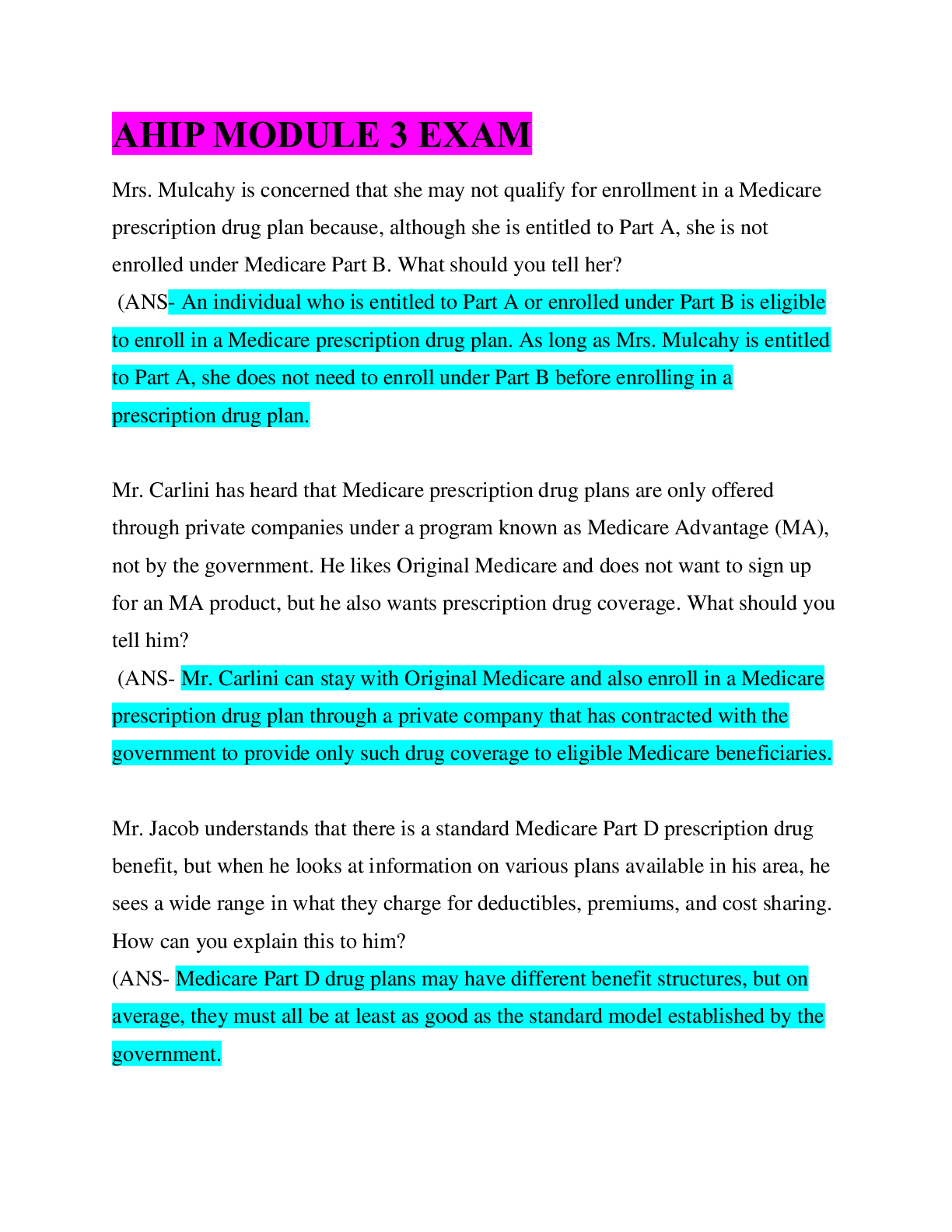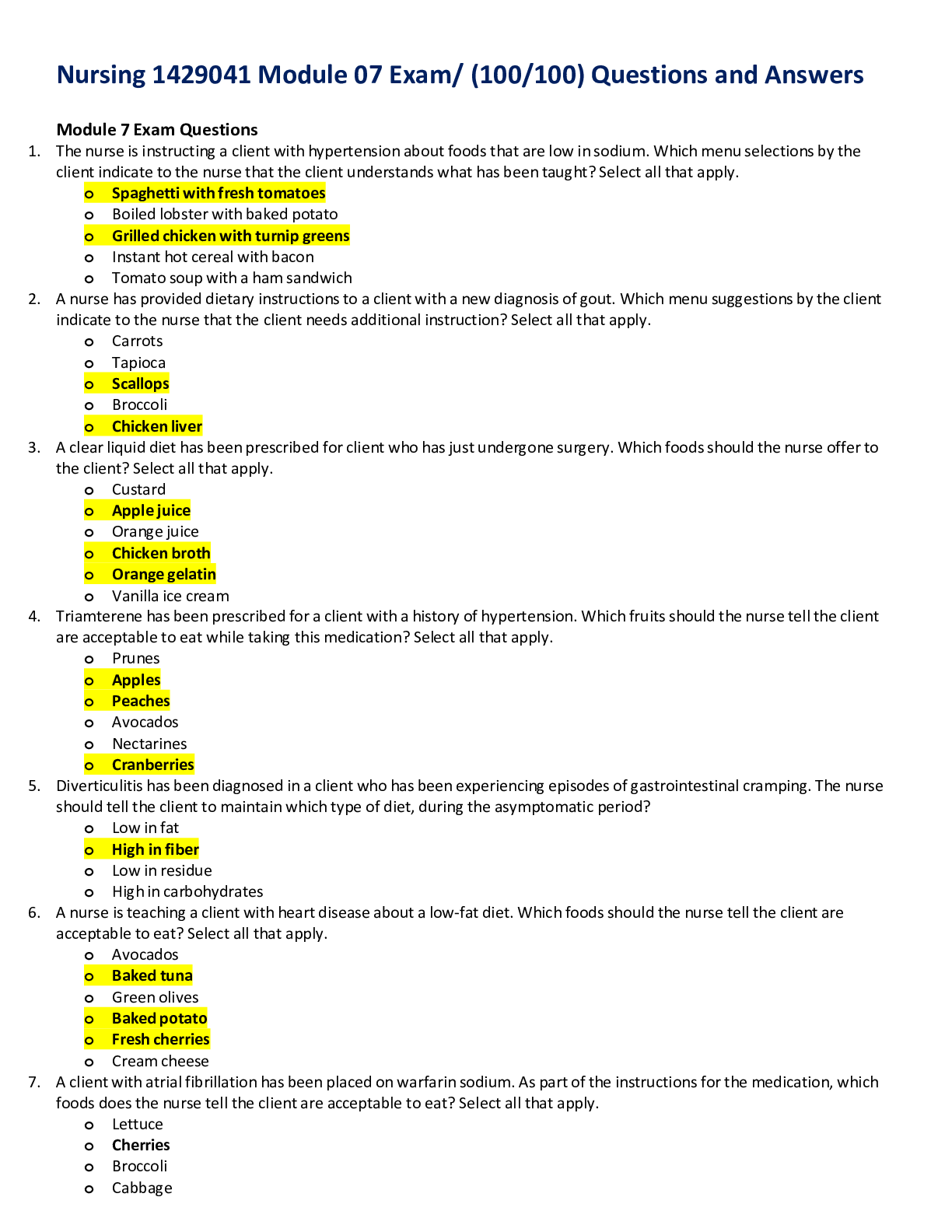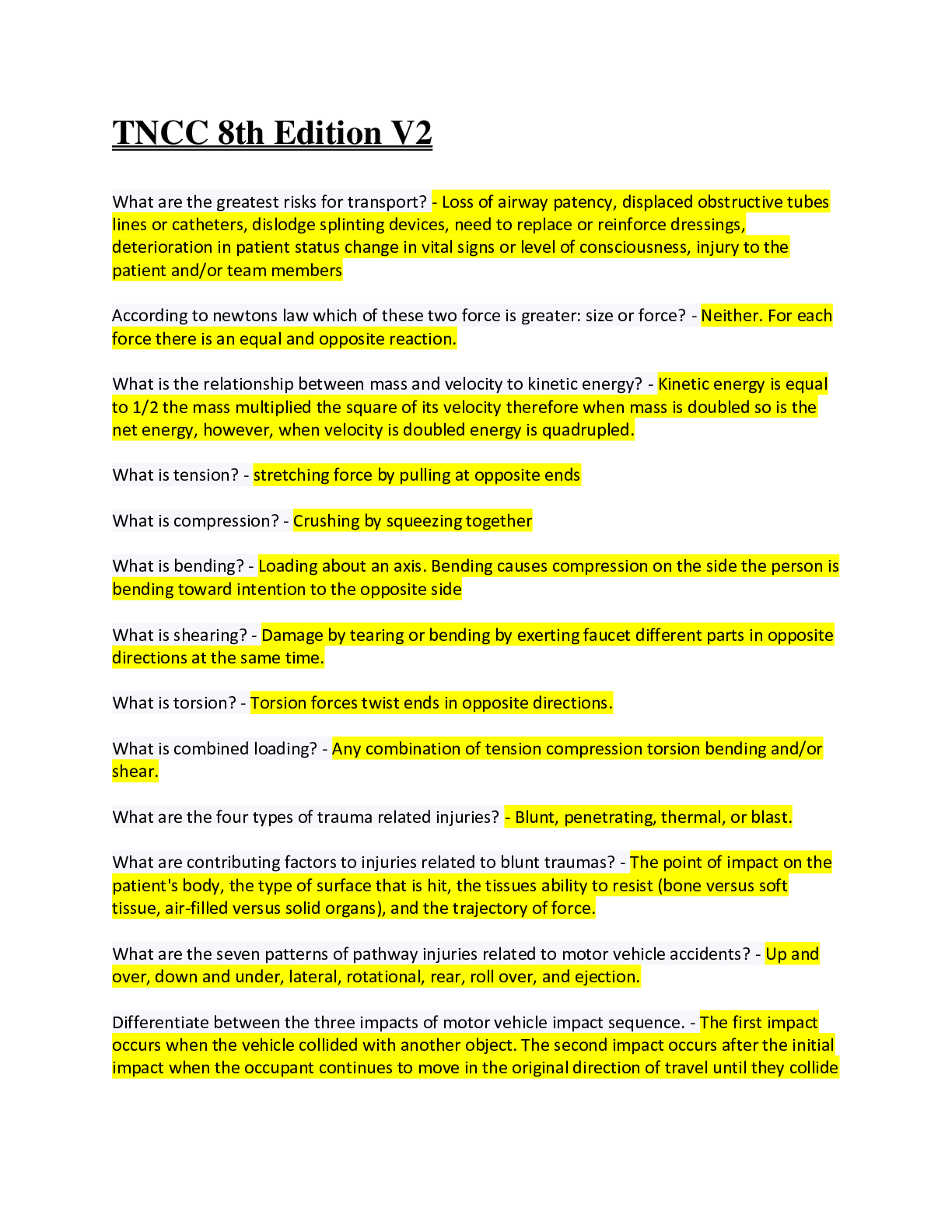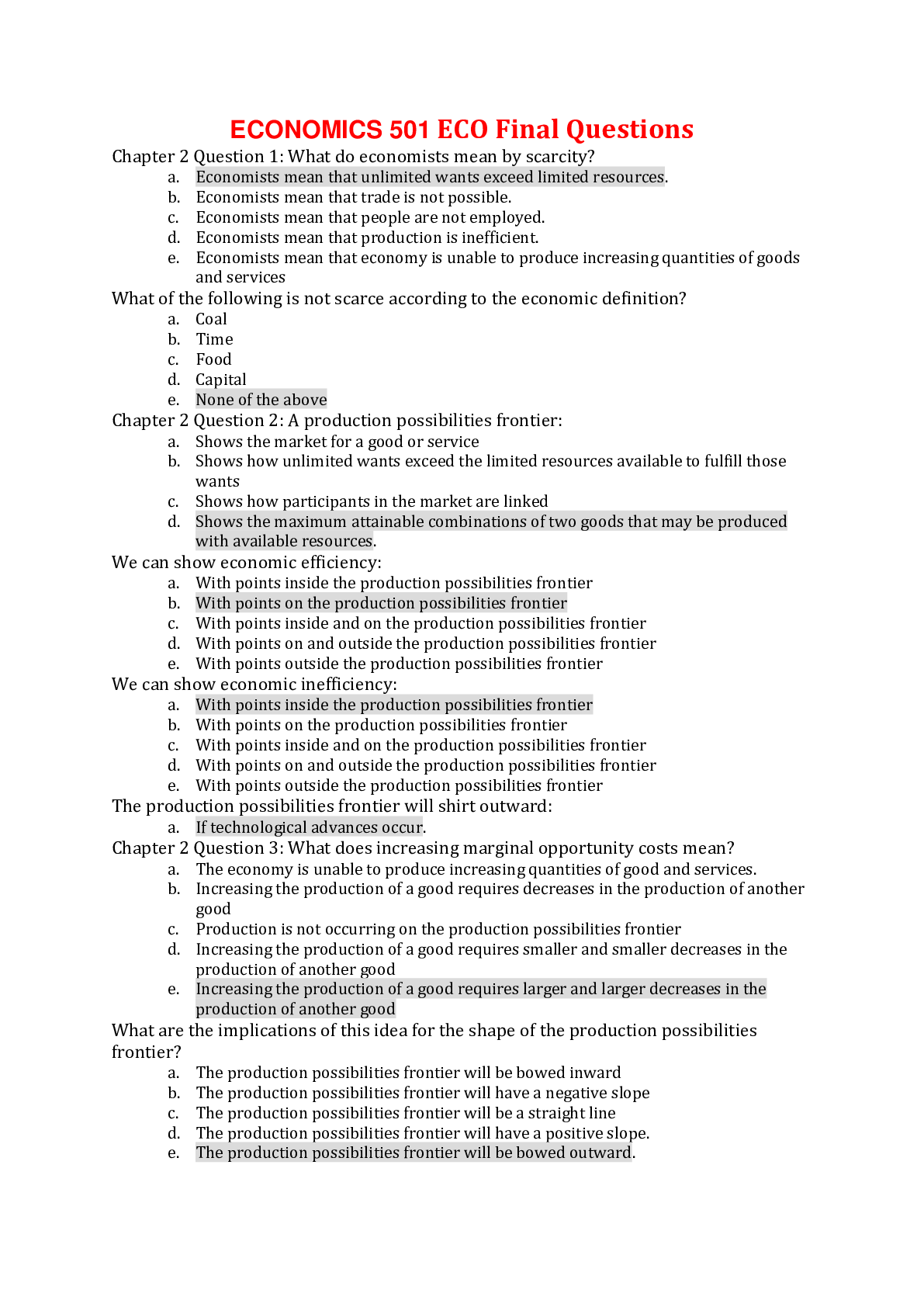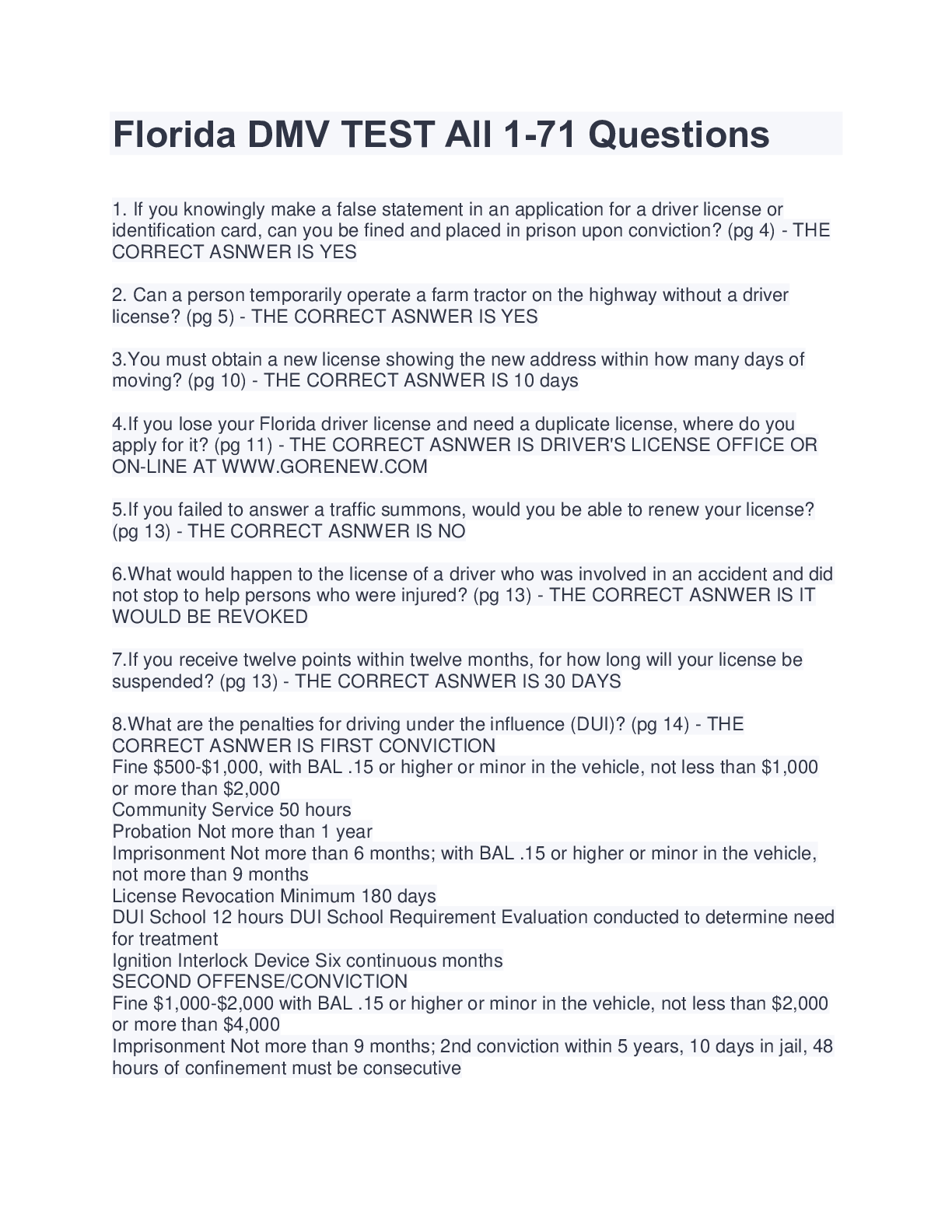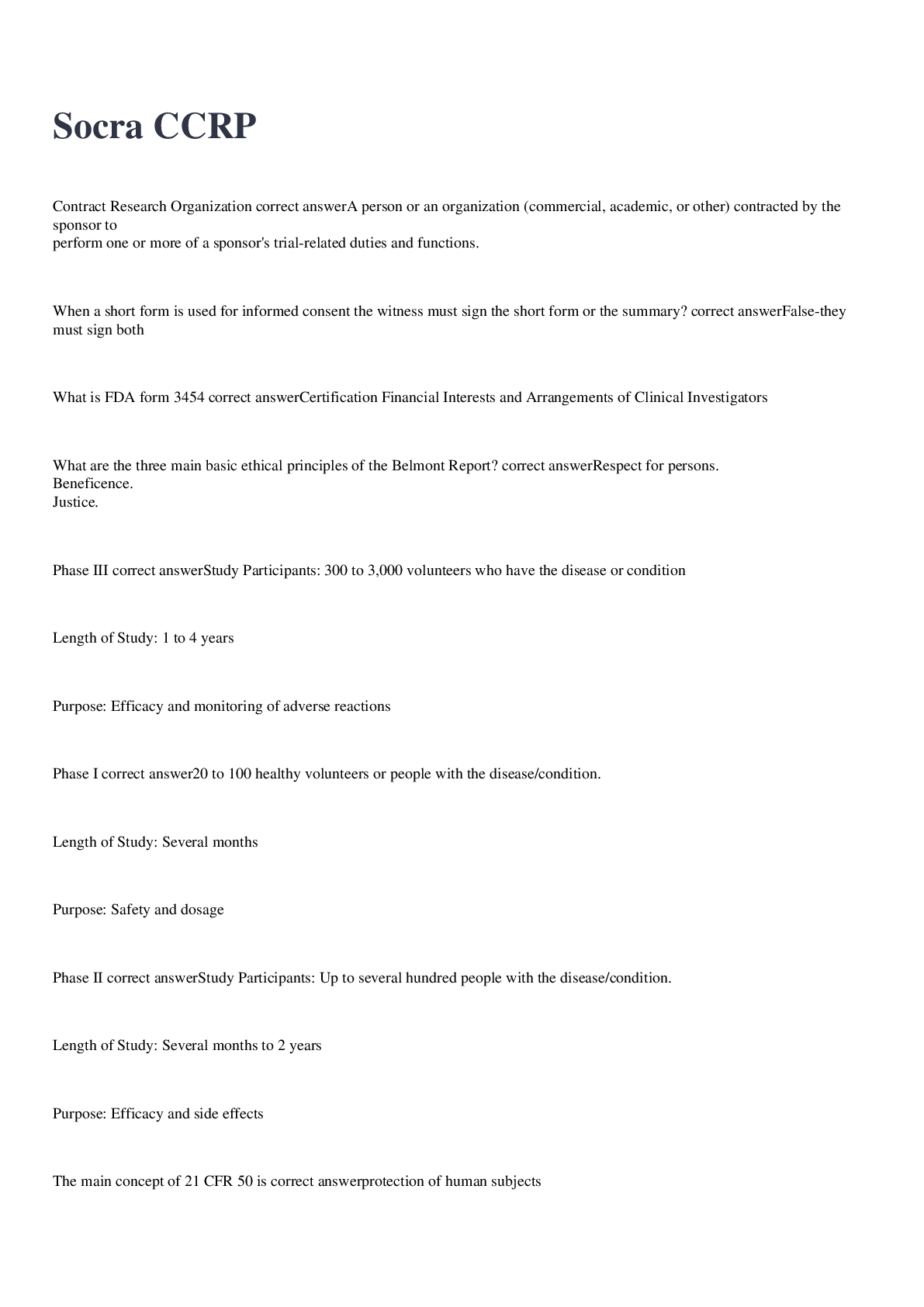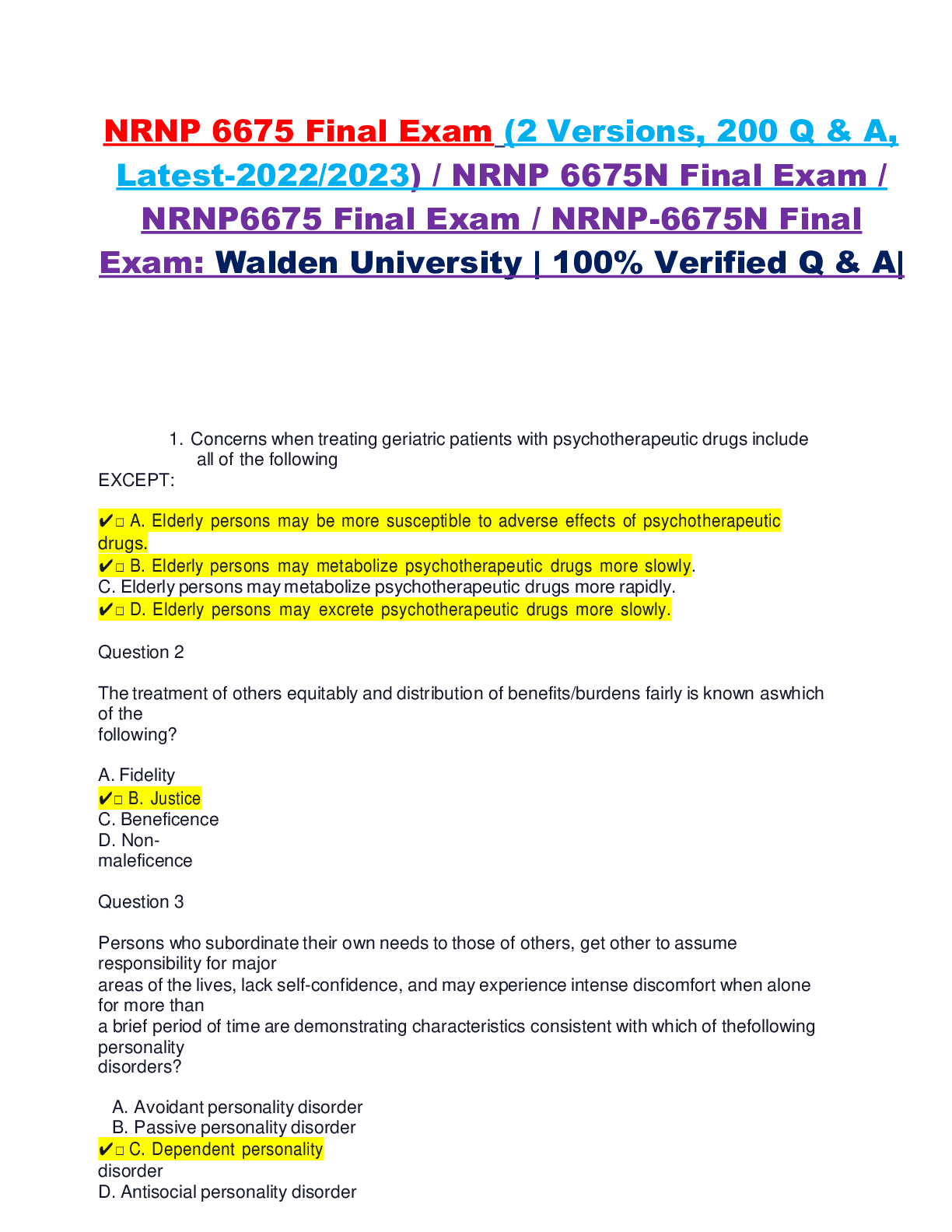*NURSING > EXAM > Nursing 1429041 Module 06 Exam/ (100/100) Questions and Answers/ GRADED A/ (LATEST UPDATE 2021/2022) (All)
Nursing 1429041 Module 06 Exam/ (100/100) Questions and Answers/ GRADED A/ (LATEST UPDATE 2021/2022)
Document Content and Description Below
Nursing 1429041 Module 06 Exam/ Questions and Answers Questions 1. Which event would require a nurse to complete and file an incident report? o A client has a seizure. o The nurse determines tha... t a client would benefit from the use of a walker to ambulate. o The nurse, preparing an intravenous infusion, notes that the battery of an intravenous infusion pump is not working. o When a visitor suddenly becomes weak and dizzy, the nurse checks the visitor’s blood pressure and takes the visitor to the emergency department for treatment. 2. A nurse, charting the administration of medications to an assigned client at 9 pm, notes that atenolol (Tenormin) was prescribed to be administered at 9 am instead of 9 pm. The nurse checks the client’s vital signs, completes an incident report, and calls the physician to report the error. The physician tells the nurse that an incident report is not needed but instructs her to monitor the client during the night for hypotension. What action should the nurse take? o Notifying the nursing supervisor o Tearing up and discarding the incident report o Telling the physician that the error warrants the completion of an incident report o Telling the nursing supervisor that the physician did not want an incident report completed and filed 3. Contact precautions are initiated for a client with methicillin-resistant Staphylococcus aureus (MRSA) infection. The nurse, providing instructions to a nursing assistant about caring for the client, tells the assistant: o To transfer the client to a semiprivate room o That gloves only are needed to care for the client o To wear gloves and a gown when changing the client's bed linen. o To wear a gown when caring for the client and remove the gown immediately after leaving the client’s room 4. A nurse hears someone calling, “Help! My bed is on fire!” On entering the room, the nurse finds a client trying to beat out the flames with a pillow. Place in order of priority the actions that the nurse should take: o 2 Pulling the nearest fire alarm o 3 Closing the door to the room o 4 Running to get the nearest fire extinguisher o 1 Removing the client from the room 5. The mother of a 3-year-old calls a neighbor who is a nurse and reports that her child just drank some window cleaner that had been stored in a cabinet. The nurse should instruct the mother to immediately: o Call a poison control center o Administer an excessive amount of fluids to induce vomiting o Call an ambulance to bring the child to the emergency department o Leave a message at the physician answering service about the incident 6. A hurricane is forecast to make landfall in 48 hours, and the staff of the emergency department of an area hospital is advised to prepare for causalities. Which action should the nurse manager who receives the telephone call regarding this warning take first? o Activating the agency disaster plan o Supplying the triage rooms with additional equipment o Increasing the number of nursing staff for the day on which the hurricane is expected o Calling the hospital maintenance department to secure the building against the storm 7. A home health nurse has instructed a client about safety measures during the use of an oxygen concentrator in the home. Which statement by the client indicates to the nurse that the client has understood the directions? Select all that apply. o “I need to follow the oxygen prescription exactly.” o “I can use my electric razor while I’m using oxygen.” o “I have to keep the oxygen concentrator out of direct sunlight.” o “I need to keep the oxygen concentrator as close to the wall as possible or put it in a corner.” o “I have to tell everyone that they can’t smoke or have an open flame within 10 feet (3 meters) of the oxygen concentrator.” 8. A nurse is providing instructions to a nursing assistant who will be caring for a client in hand restraints. The nurse instructs the nursing assistant to release the restraints to permit muscle exercise: o Every 2 hours o Every 3 hours o Every 4 hours o Every 30 minutes 9. A community health nurse working in a school setting is concerned because parents are not participating in health activities designed to promote child safety. In this situation, the most appropriate initial action is: o Implementing a child safety program o Planning a focused child safety program o Performing an analysis of health problems related to child safety o Determining the appropriateness of the planned health activity 10. The nurse administers a dose of ramipril (Altace) 2.5 mg to a client at 9 am. While documenting administration of the medication, the nurse discovers that 1.25 mg, not 2.5 mg, was the prescribed dose. The nurse assesses the client, completes an incident report, and notifies the physician and nursing supervisor of the error. What statement does the nurse add to the client’s record? o An incident report was completed and filed. o Ramipril (Altace) 2.5 mg was administered at 9 am. o Twice the amount of the prescribed ramipril was administered at 9 am. o Client’s blood pressure was 128/82 mm Hg after the administration of the incorrect dose of ramipril. 11. A home health nurse has been called to the home of an older postoperative cardiovascular client by the client’s son. The son tells the nurse, “We’re using a hospital bed here at home, but my mother has fallen out of bed three times.” Which observation by the nurse reflects an increased risk of this client’s falling out of bed? o The client’s bed is in a low position. o The client is oriented to person, place, and time. o The caregiver uses the overbed table for feedings. o The caregiver leaves both siderails down while the client is in bed. 12. A community health nurse is providing information to local residents about the transmission of anthrax. Through which body systems does the nurse tell the residents that anthrax can be contracted? Select all that apply. o Skin o Lungs o Immune o Urinary o Lymphatic o Gastrointestinal 13. A nurse is preparing a chemotherapy infusion to be administered to a client with a diagnosis of Hodgkin’s disease. Which precaution should the nurse take while working with this intravenous (IV) infusion? o Wearing gloves and a mask o Wearing gloves and a gown o Wearing gloves, a mask, and eye protection o Wearing gloves, a mask, and a head covering 14. A nurse is preparing a continuous intravenous (IV) infusion at the medication cart. As the nurse goes to attach the IV tubing port to the solution bag, the tubing drops, hitting the top of the medication cart. Which action should the nurse take to maintain asepsis? o Obtaining new IV tubing o Obtaining a new IV solution bag o Scrubbing the tubing port with an alcohol swab o Wiping the tubing port with povidone-iodine solution (Betadine) 15. A home health nurse is visiting a client with tuberculosis (TB). Which action by the client tells the nurse that the client understands the necessary respiratory precautions to be taken at home? o Staying secluded in the bedroom o Wearing an oxygen mask at all times o Keeping the house closed up to minimize the spread of disease o Disposing of contaminated tissues in a container with a leak-proof bag 16. A home health nurse teaches a client about home modifications to reduce the risk of falls. Which statements by the client indicate a need for further teaching? Select all that apply. o “I need to use night lights.” o “I need to remove my wall-to-wall carpeting.” o “I need to get handrails put up in the bathroom.” o “I need to use the staircase handrails when I go up the stairs.” o “I should walk barefoot as much as possible so that I’ll know about any wet spots on the floor.” 17. A nurse caring for a client who is under airborne precautions notes that the client is scheduled for a nuclear scan. Which action on the part of the nurse is appropriate? o Planning to have the nuclear scan performed at the bedside o Asking the technicians in the nuclear scan department to wear masks o Placing a surgical mask on the client for transport and for contact with other individuals o Calling the nuclear medicine department and telling the technician that the test will have to be delayed until airborne precautions have been discontinued 18. A nurse employed in a physician’s office hears a client in the waiting room call out, “Help! Fire!” The nurse rushes to the waiting room and finds that the wastebasket is on fire. The nurse immediately: o Confines the fire o Extinguishes the fire o Activates the fire alarm o Removes the clients from the waiting room 19. A nurse enters the laundry room to empty a bag of dirty linen and discovers a fire in a laundry basket. What action should the nurse take first? o Confining the fire o Extinguishing the fire o Activating the fire alarm o Running for the fire extinguisher 20. The safety department is providing a yearly educational session on fire safety and the use of fire extinguishers. A nurse is asked to demonstrate the use of a fire extinguisher after the session. The nurse demonstrates appropriate use of the fire extinguisher by first: o Aiming at the base of the fire o Pulling the pin on the fire extinguisher o Squeezing the handle of the extinguisher o Sweeping from the top to the bottom of the fire with the extinguisher 21. A nurse provides instruction to a new nursing assistant regarding the application of a restraint to a client. The nurse watches as the nursing assistant applies the restraint. What observation tells the nurse that the nursing assistant is using correct procedure? o The assistant applies a tie knot in the restraint strap. o The assistant attaches the restraint straps securely to the siderails. o The assistant applies the restraint so that the strap does not tighten when force is applied against it. o The assistant secures the restraint in such a way that it is impossible to slip a finger between the restraint and the client’s skin. 22. A registered nurse is instructing a group of nursing assistants in the principles of body mechanics. Which of these observations tell the nurse that a student is using the principles appropriately? Select all that apply. o The assistant leans forward when turning a client in bed. o The assistant positions a box that is to be lifted between his knees. o The assistant turns his back to change position while moving a client. o The assistant keeps the object to be moved as close to his body as possible. o The assistant helps a client requiring total care into a chair without additional assistance. 23. A home care nurse visits a client who lives in a small apartment to perform an admission assessment. During the home safety assessment, the client asks the nurse whether it is safe to use a space heater. What is the appropriate response by the nurse? o “A space heater should never be used in an apartment.” o “A space heater can be used as long as it is kept at a low setting at all times.” o “A space heater can be used as long as it is kept in the bedroom at night in case a fire occurs.” o “A space heater can be used as long as it’s placed at least 3 feet (1 meter) from anything that may ignite.” 24. A nurse is preparing to initiate a continuous tube feeding, using a tube-feeding pump. On bringing the pump to the bedside and preparing to plug the pump in, the nurse discovers that there is no available plug in the wall socket. What should the nurse do? o Plug in the pump cord into an available plug above the sink o Ask the physician to change the prescription to intermittent feedings o Determine the need for the appliances now plugged into the needed wall socket o Use a regular extension cord to allow the use of more than one electrical appliance 25. View Video. A nurse, preparing a sterile field on which to perform a dressing change, places the sterile drape on the overbed table. Which of these actions on the part of the nurse indicate correct understanding of the principles of aseptic technique? Select all that apply. o Holding the pair of sterile forceps below waist level area o Positioning the sterile field so that it remains in full view o Reaching across the sterile field to pick up a sterile gauze o Leaving the room to obtain a bottle of sterile normal saline solution o Picking up a pair of sterile scissors from the sterile field with a sterile gloved hand o Pouring sterile wound cleansing solution into a sterile cup before donning sterile gloves 26. A licensed practical nurse (LPN) tells the registered nurse (RN) that she administered acetaminophen (Tylenol) to a client by way of the rectal route rather than the prescribed oral route because the client was extremely nauseated. The RN most appropriately: o Asks the LPN to complete and file an incident report o Asks the LPN to check the client in 30 minutes to see whether the nausea has subsided o Tells the LPN that she made a sound judgment in administering the medication by way of the rectal route o Instructs the LPN to write “pr” (per rectum) on the medication record next to the time at which the medication was administered 27. A nurse receives a telephone call from the admissions office and is told that a client scheduled for an internal radiation implant will be admitted to the nursing unit. Which of the following precautions does the nurse include in the client’s plan of care? o Wearing gloves when emptying the client’s bedpan o Allowing the client to ambulate in the hall only once a day o Placing the client in a semiprivate room at the end of a hallway o Placing used linen in double bags and sending a bag to the laundry room every evening 28. A nursing instructor is observing a nursing student who is practicing the use of standard precautions in the nursing laboratory. Which of the following observations by the instructor indicates a need for further teaching? o The nursing student changes gloves between tasks and procedures. o The nursing student washes hands before making contact with the client. o The nursing student wears a gown to change the bed of an incontinent client. o The nursing student washes her hands before glove removal after emptying a Foley bag. 29. A physician writes a prescription for the application of a heating pad to a client’s back. Which of the following actions should the nurse take when implementing this prescription? Select all that apply. o Placing the heating pad under the client o Adjusting the heating pad to the high setting o Frequently assessing the client’s skin for signs of burns o Assessing the client’s medical history and risk factors for burns o Assessing the heating pad periodically for proper electrical function 30. A home care nurse is instructing a client in the use of ice packs to treat an eye injury. The nurse instructs the client to: o Place the ice pack directly on the eye o Avoid the use of commercially prepared ice bags o Keep the ice pack on the eye continuously for 24 hours o Wrap a plastic bag filled with ice in a pillowcase and place it on the eye 31. A fever develops in a client who has been hospitalized for 2 months and is receiving parenteral nutrition by way of a central venous line, and central venous line–related sepsis is diagnosed. The nurse interprets this finding as meaning that this infection is: o An iatrogenic infection o A result of bacterial colonization o A community-acquired infection o A healthcare-associated infection 32. A nurse educator is providing inservice sessions to the nursing staff regarding employee safety and the prevention of occupationally acquired HIV infection. Which of the following precautions does the nurse instruct the nursing staff to take as a means of preventing accidental needlesticks? Select all that apply. o The use of latex gloves o The use of shielded needles o The use of recessed needles o The use of needleless devices o Disposal of needles in special puncture-resistant containers 33. A nurse is preparing to clean up a blood spill on the client’s bedside table that occurred when a blood tube containing a specimen from the client broke. What steps should the nurse take to clean up the blood spill? Select all that apply. o Using tongs to collect any broken glass o Wearing gloves for the cleanup procedure o Placing the pieces of broken glass in a plastic bag o Blotting up the spill with a face cloth or cloth towel o Disinfecting the area of the blood spill with a dilute bleach solution 34. The unit supervisor of an emergency department (ED) is called at home and told by an emergency department nurse who is on duty that an airplane crash has occurred and numerous casualties will be arriving at the ED. What should the initial response by the unit supervisor be? o “Has the disaster plan been activated?” o “Call as many nursing staff as you can to come in to work.” o “Make sure all of the rooms are well stocked with supplies.” o “Be sure that the nursing staff finds as many stretchers as they can.” 35. A community health nurse is providing an educational session on childhood poisoning at a local school. The nurse tells the group that when an accidental poisoning occurs the first action is to: o Induce vomiting o Call an ambulance o Call the poison control center o Bring the child to the emergency department (ED) 36. A client undergoing chemotherapy is found to have an extremely low white blood cell count, and neutropenic precautions, including a low- bacteria diet, are immediately instituted. Which of these food items will the client be allowed to consume? Select all that apply. o Fresh apple o Raw celery o Italian bread o Tossed salad o Baked chicken o Well-cooked cheeseburger 37. Which actions should the nurse take in the event of an accidental poisoning? Select all that apply. o Saving vomitus for laboratory analysis o Placing the client in the supine position o Determining the type and amount of substance ingested o Removing any visible materials from the nose and mouth o Inducing vomiting if a household cleaner has been ingested o Assessing the client’s airway patency, breathing, and circulation 38. A nurse is assigned to care for a client with an infection caused by methicillin-resistant Staphylococcus aureus (MRSA). The client has an abdominal wound that requires irrigation and has a tracheostomy attached to a mechanical ventilator that requires frequent suctioning. While gathering the needed supplies before entering the client’s room, which necessary protective items does the nurse obtain? Select all that apply. o Mask o Gown o Gloves o Face shield o Shoe protectors 39. A nurse is assisting with disaster relief after a tornado. The nurse’s goal with the overall community is to prevent as much injury and death resulting from the uncontrollable event as possible. Finding safe housing for survivors, providing support to families, organizing counseling sessions, and securing physical care when needed are all examples of which level of prevention? o Initial o Primary o Tertiary o Secondary 40. A nurse in a post-anesthesia care unit (PACU) receives a client from the operating room. For what finding should the PACU nurse assess the client first? o Airway patency o Active bowel sounds o Adequate urine output o Orientation to surroundings 41. A staff nurse caring for a client with a head injury notes that the client is restless and pulling at the intravenous (IV) line. The client’s primary health care provider does not want to prescribe sedation, and the family has requested that the client not be restrained. Which action by the nurse is best? o Asking a family member to sit with the client o Asking a nursing assistant to monitor the client o Staying with the client and consulting with the nurse manager about the situation o Telling the family that the application of wrist restraints is critical in preventing injury to the client 42. A nurse manager of an emergency department (ED) arrives at work and is told that four registered nurses scheduled to work will not be reporting to work because they are ill. Every trauma room is busy, and emergency medical services (EMS) has just called to report that several victims involved in a 10-car wreck on the interstate will be brought to the ED. The nurse manager initially manages this situation by: o Telling EMS to take the victims to another hospital o Closing the emergency department temporarily to incoming clients o Calling the nursing supervisor to discuss activation of the disaster plan o Demanding that the nurses from the night shift stay until all of the victims have been treated 43. A nurse responds to an external disaster that occurred in a large city when a building collapsed. Numerous victims require treatment. Which victim should the nurse attend to first? o A victim who has died of multiple serious injuries o A hysterical victim who has sustained a head injury o An alert victim who has numerous bruises on the arms and legs o A victim with a partial amputation of a leg who is bleeding profusely 44. A nurse giving a client a bed bath drops the towel on the floor. The nurse should: o Use a bath blanket as a towel o Borrow a towel from the client’s roommate o Wash her hands, pick up the towel, and shake the towel out o Wash her hands and go to the linen room to obtain another towel 45. A nurse is attending an inservice program on disaster preparedness. Which of the following events is described as an example of a natural disaster? o Drought o Bus accident o Terrorist attack o Toxic waste spill 46. A nurse manager tells the nursing staff that the agency’s disaster preparedness plan will be distributed to all employees for review. The nurse manager states that the plan is an important component of disaster readiness because it primarily: o Identifies the location of healthcare supplies o Identifies the types of disasters that may occur o Aids determination of how victims will be triaged o Describes a formal plan of action for the coordination of a response 47. A nurse is reading an article about the role of the American Red Cross (ARC) in a disaster. Which of the following responsibilities does the article ascribe to the ARC? o Declaring a disaster o Providing disaster relief o Activating disaster medical assistant teams o Developing a federal disaster response plan 48. A nurse leading an educational session about terrorism for members of the community is discussing anthrax. Which of the following pieces of information should the nurse provide to the group attending the session? Select all that apply. o Anthrax is never fatal. o No vaccine to prevent anthrax is available. o Anthrax can be transmitted from person to person. o A blood test is available for the detection of anthrax. o One way that anthrax can be contracted is through the skin. 49. According to the Federal Emergency Management Agency (FEMA) description of the phases of disaster management, in which phase are the available resources for the care of infants, older clients, the disabled, and people with chronic health problems addressed? o Response o Recovery o Mitigation o Preparedness 50. An older client is extremely anxious after admission, having never been hospitalized before. To help provide a safe environment and minimize the stress of hospitalization on the client, what does the nurse plan to do? Select all that apply. o Keep visitors to a minimum o Acknowledge the client’s feelings o Provide information about hospital routines o Put the client in a room far from the nurses’ station o Keep the door open and the room lights on at all times o Allow the client to have as many choices regarding his care as possible 51. A nurse is preparing a disaster preparedness checklist, identifying emergency plans and supplies that will be needed in the event of a disaster, for a community group. Which instructions should be included on the list? Select all that apply. o Have a first aid kit available. o Have a firearm or other weapon available. o Plan a meeting place for family members. o Obtain a 1-day supply of water (1 gallon per person). o Have an adequate supply of prescription medications. o Have a battery-operated radio and a flashlight and batteries available. 52. A triage nurse in an emergency department (ED) is attending to the victims of a train crash. All victims are alert. Which of these clients does the nurse assign to the emergent category? Select all that apply. o A victim with respiratory distress o A victim with a fractured humerus o A victim with partial amputation of the foot o A victim with a forehead laceration that is not bleeding o A victim with multiple nonbleeding bruises of the arms and legs 53. A nurse is questioning a client about hazards in the home environment. Which of the following items in the home is an indication that the client requires instruction about safety? Select all that apply. o Untacked rugs on the stairs o Small rugs in the living room o Carpet on stairs secured with tacks o Clothes hamper at the end of the hallway o Cereal boxes, canned foods, and infrequently used cooking utensils stored on top of the refrigerator 54. A home health nurse is performing an assessment of a client’s skin. The nurse, noting multiple threadlike lines, both straight and wavy, beneath the skin, recognizes the presence of scabies. Which of the following precautions should the nurse institute before completing the assessment of the client? o Putting on a pair of gloves o Donning a mask and gloves o Putting on a gown and gloves o Avoiding sitting on the client’s furniture 55. An industrial nurse at a large factory provides information to the employees in the mailroom and shipping department about the signs of skin (cutaneous) anthrax. For which early sign of cutaneous anthrax does the nurse tell the employees to check their skin? o An open ulcer o An itchy bump o A weeping blister o A black skin area of skin 56. A nurse educator is providing an inservice program to emergency department nurses about the signs of inhalation anthrax. The nurse educator tells the nurses that one early indication of inhalation anthrax is: o Hemorrhage o Signs of shock o Flulike symptoms o Respiratory distress 57. A post office employee with suspected skin anthrax asks the emergency department nurse whether the infection is curable. What is the appropriate response by the nurse? o “You really need to ask your doctor about that.” o “That’s hard to say. We won’t know for a week or two.” o “Antibiotic therapy is usually prescribed and will cure the infection.” o “It is not curable, but fortunately, unlike inhalation anthrax, it is not deadly.” 58. The nursing staff in an emergency department is reviewing and updating the disaster preparedness plan. The staff members, discussing ways to help prevent the transmission of smallpox, know that this infection is transmitted by which route? o Enteric o Inhalation o Gastrointestinal o Through open wounds 59. A client with paraplegia has spasticity of the leg muscles. Which interventions should be included in the plan of care for this client? Select all that apply. o The use of restraints to immobilize the limbs o Range-of-motion exercises of the affected limbs o An as-needed prescription for a muscle relaxant o Removal of potentially harmful objects near the client o The use of padding against the client’s legs when the client is sitting in a wheelchair 60. A military nurse who is in charge of planning a vaccination clinic to administer the smallpox vaccine to military personnel is preparing a pamphlet that sets forth guidelines for care of the vaccination site. Which guideline should the nurse include in the pamphlet? o Soak the scab that forms with warm water every day. o Keep the vaccination site open to air as much as possible. o Apply an antihistamine ointment to the scab to prevent itching. o Avoid sharing towels or other items that have come in contact with the vaccination site. 62. A nurse in a long-term care facility recognizes the need to place wrist restraints on a client, but the client does not want the restraints applied. The appropriate nursing action would be to: o Contact the physician o Apply the restraints anyway o Medicate the client with a sedative, then apply the restraints o Compromise with the client and use only one wrist restraint instead of two 63. After discussing the use of restraints with a client and family, a physician has written a prescription for wrist restraints to be applied to a client. The nurse instructs the nursing assistant to apply the restraints. Which of the following observations by the nurse indicates that the nursing assistant is using the restraints safely and correctly? Select all that apply. o The restraints are applied tightly. o The restraints are being released every 2 hours. o A safety knot has been used to secure the restraints. o The restraints have been tied to the siderails of the bed. o The call light has been placed within reach of the client. 64. A nurse caring for a 9-month-old who has undergone repair of a cleft palate applies elbow restraints to the child. The mother visits her child and asks the nurse to remove the restraints. According to the guidelines for the use of restraints, what should the nurse do in response to the mother’s request? o Remove both restraints o Remove a restraint from one extremity o Tell the mother that the restraints may not be removed o Loosen the restraints after telling the mother that they may not be removed 65. A community health nurse is asked to assist in developing a community disaster plan. The nurse determines that this responsibility is a component of which disaster management phase identified by the Federal Emergency Management Agency (FEMA)? o Response o Recovery o Mitigation o Preparedness 66. A nurse is admitting a postoperative client from the postanesthesia care unit to the surgical nursing unit. Which of the following measures should the nurse take for the safety of the client? o Asking the client to slide from the stretcher to the bed o Quickly moving the client from the stretcher to the bed o Putting the siderails up after moving the client from the stretcher o Uncovering the client before making the transfer from the stretcher to the bed 67. A nurse prepares to teach a client with chronic vertigo about safety measures to help prevent exacerbation of symptoms and injury. Which instructions should the nurse provide to the client? Select all that apply. o “Change positions slowly.” o “Remove clutter from your home.” o “Use public transportation as much as possible.” o “Drive your car only if you’re not feeling dizzy.” o “Turn your head slowly when someone speaks to you.” 68. An emergency department (ED) nurse is triaging victims of an explosion at a nearby manufacturing plant. To which victims should the nurse assign the emergent (priority 1) designation? Select all that apply. o A victim with a limb amputation o A victim who is alert but complaining of loss of vision o A victim who is bleeding profusely from a head laceration o A victim who is dazed and staggering around the other victims o A victim who has sustained minor bruising of an arm and the lower legs 69. A client with an infection is receiving antibiotics by way of intramuscular (IM) injection. The client is also receiving subcutaneous (SC) injections of heparin. Which precaution does the nurse understand is most appropriate to help ensure the safety of this client? o Doubling the dose of anticoagulant o Applying a pressure bandage to the site after each IM injection o Applying prolonged pressure to the sites of the IM and SC sites o Decreasing the sizes of the needles used for the IM and SC injections 70. A nurse, assessing a client’s readiness for discharge, is performing a home safety assessment to determine whether there are any environmental hazards in the home. Which of the following statements, if made by the client, would prompt the nurse to investigate further? Select all that apply. o “I live in a single-story house.” o “I don’t have any nightlights in the house.” o “I’ve removed the scatter rugs from the house.” o “I keep my personal items within reach when I sit in my easy chair.” o “I haven’t changed the batteries in the smoke detectors in my home for quite a few years now.” 71. A nurse caring for a client with leukemia who is undergoing chemotherapy reviews the latest laboratory results and notes that the neutrophil count is below 500 cells/mm3 (0.5 x 109/L). Which of the following interventions does the nurse implement on the basis of this finding? Select all that apply. o Providing a soft toothbrush for oral care o Monitoring the client’s oral temperature o Maintaining sterile occlusion of intravenous (IV) catheters o Requiring the client to use an electric shaver rather than a razor o Performing meticulous skin decontamination before venipuncture o Avoiding overinflation of the blood pressure cuff and rotating the cuff among several sites when measuring the blood pressure 72. A client with a new diagnosis of tuberculosis (TB) is being admitted to the hospital. During the collection of data from the client, which of the following considerations is especially important? o The religious affiliation or church of preference o The names of close friends and family members o What medications have been prescribed and what the client knows about their side effects o The name of the person from whom the client contracted TB, so that the person may be reported for follow-up care 73. A client with osteoporosis is at risk for falls. Which statement by the client indicates the need for instruction regarding measures to prevent falls? o “I took the bathmat out of my tub.” o “I use a shower chair when I bathe.” o “I’ve placed nightlights in my hallway.” o “The railings on my stairs are sturdy and secure.” 74. An adolescent client asks the nurse questions about the transmission of the Epstein-Barr virus (infectious mononucleosis). By which route should the nurse tell the client that the disease is transmitted? o Fecal-oral o Airborne particles o Respiratory droplets o Close intimate contact 75. A teenage client returns to the gynecological (GYN) clinic for a follow-up visit after diagnosis and initial treatment of a sexually transmitted infection (STI). Which statement by the client indicates the need for further teaching? o “I finished all the antibiotic, just like you said.” o “I know you won’t tell my parents that I’m sick.” o “I always make sure my boyfriend uses a condom.” o “My boyfriend doesn’t have to come in for treatment.” 76. A nurse has provided instructions to a mother regarding the use of safety seats in car travel for her newborn infant. Which statement by the mother indicates understanding of the instructions? o “I’ll put the baby’s car seat in the front seat, facing forward and reclined a little.” o “I’ll put the baby’s car seat in the front seat, facing backward and reclined a little.” o “I’ll put the baby’s car seat in the middle back seat, facing forward and reclined a little.” o “I’ll put the baby’s car seat in the middle back seat, facing backward and reclined a little.” 77. During a laboratory training session, the nurse is watching as a nursing assistant repositions a client. Which observation tells the nurse that further training is necessary? o The nursing assistant positions himself close to the client. o The nursing assistant keeps his neck, back, pelvis, and feet aligned. o The nursing assistant encourages the client to assist as much as possible. o The nursing assistant keeps his knees straight and his feet close together. 78. A nurse preparing to perform a sterile dressing change notes that the covering of a package of sterile 4 × 4 gauze pads has a small tear. Which action should the nurse take? o Discarding the package o Using the gauze pads, because the tear was small o Examining the gauze pads and using them as long as they appear untouched o Discarding the gauze pad closest to the outside of the package and using the others 79. A nurse preparing a sterile field is placing sterile items on the field. The nurse understands that the border of the sterile drape is considered contaminated. How many inch(es) is the contaminated border? Type your answer in the box provided. 1 inch(es) 80. A nurse who is preparing to leave the room of a client who is under airborne precautions needs to remove the following protective items: gloves, gown, mask, and goggles. Place in order of priority the items that need to be removed. o 4 Mask o 2 Goggles o 3 Gown o 1 Gloves 81. A nurse employed on a medical care unit is administering medications. She tells a client that she is going to administer his furosemide (Lasix) through his intravenous (IV) line. The client tells the nurse that he takes this medication orally at home every day and is concerned that it is being administered by way of a different route. The nurse should take which most appropriate action? o Verifying the physician’s prescription o Sitting and talking to the client to alleviate his concern o Explaining to the client that the oral route will not permit the medication to exert an adequate effect o Letting the client know that most medications are administered by way of the IV route when a client is hospitalized 82. At the beginning of the 7 am–3 pm shift, the nurse checks her assigned clients and notes that a client with diabetes mellitus has an intravenous (IV) bag of 5% dextrose in water hanging and infusing instead of the prescribed 0.9% normal saline. The nurse verifies the prescription and changes the IV solution to the correct one. The nurse assesses the client noting that the blood glucose level at 7:15 am was 149 mg/dL (8.3 mmol/L), notifies the physician, and completes an incident report. Which information about the event is appropriate for inclusion on the incident report? Select all that apply. INCIDENT REPORT Events that Occurred o The physician was contacted. o The blood glucose level at 7:15 am was 149 mg/dL(8.3 mmol/L). o An IV solution of 5% dextrose in water was infusing at 7 am. o A solution of 5% dextrose in water was infusing instead of the prescribed 0.9% normal saline solution. o A 5% dextrose in water solution is not usually prescribed for clients with diabetes, and the solution was changed immediately on its discovery. 83. A nurse performs an evaluation to determine whether a client’s home is electrically safe. Which finding indicates the need for further investigation and intervention? o Wiring for the television runs under the carpet. o Electrical cords are free of frayed and damaged wires. o Electrical kitchen appliances are located away from the sink. o A safety-type extension cord is secured to the floor with electrical tape. 84. Which of the following safety guidelines should the nurse include in the plan of care for a client with an internal radiation implant? Select all that apply. o Wear a lead shield when in the client’s room. o Limit visits from family to 60 minutes per day. o Wear a dosimeter film badge when in the client’s room. o Allow children to visit the client as long as they are at least 12 years old. o Keep all bed linens and dressings in the client’s room until the implant is removed. 85. A sedated client is being transported to the radiology department on a stretcher. Which type of restraint should the nurse suggest applying to help ensure the client’s safety? o Belt o Wrist o Elbow o Mitten 86. A hospitalized client, experiencing confusion, is at risk of falling because she continually tries to climb out of bed. Which of these safety devices that the nurse might suggest is the least restrictive? o Belt o Wrist o Elbow o Ambularm 87. Which of the following points should the nurse include when documenting information about a client who is wearing wrist restraints? Select all that apply. o The client’s temperature o The client’s 24-hour urine output o Skin integrity of the restrained body part o The procedure used in applying the restraint o The date and time of application of the restraint o Circulatory and neurovascular status of the restrained extremities 88. Which of the following actions are in keeping with the principles of standard precautions? Select all that apply. o Handwashing between client contacts o Cleaning of blood spills with soap and warm water o Discarding needles in puncture-resistant containers o Handwashing before removal of a pair of soiled gloves o Wearing a face shield as a part of the protective garb during a wound irrigation o Wearing a gown and gloves when changing the linens on the bed of a client with a draining lesion of the leg 89. A nurse is reading the history and physical examination findings of an older client who has just been admitted to the hospital. Which findings documented in the history indicate an increased risk for accidents? Select all that apply. o The client’s range of motion is limited. o Transmission of hot impulses is delayed. o The client’s peripheral vision is decreased. o The client complaints of frequent nocturia. o High-frequency hearing tones are perceptible. o Voluntary and autonomic reflexes are slowed. 90. The nurse plans to wear this protective mask (see figure) when caring for clients with certain disorders. What are these disorders? Select all that apply. o Scabies o Hepatitis A o Tuberculosis o Pharyngeal diphtheria o Streptococcal pharyngitis o Meningococcal pneumonia 91. Wrist restraints have been prescribed for a client who is constantly pulling at his gastrostomy tube. Which findings does the nurse, developing a care plan, recognize as unexpected outcomes related to the use of restraints? Select all that apply. o The client becomes agitated. o The skin under the restraint is red. o The client’s left hand is pale and cold. o The client verbalizes the reason for the restraints. o The client is unable to reach the gastrostomy tube with his hands. o The client slips his hand from its restraint and pulls at his gastrostomy tube. 92. A nurse is discussing accident prevention with the family of an older client who is being discharged from the hospital after hip surgery. This client has a tendency to be forgetful. Which items in the home increase the client’s risk for injury? Select all that apply. o A nightlight in the bathroom o Elevated toilet seat with armrests o Cooking equipment such as a stove o Smoke and carbon monoxide detectors o Common household objects such as doormats o A water heater thermostat adjusted to a low setting 93. In which of the following situations would the nurse use this type of restraint (mitten)? Select all that apply. o To secure the shoulders and the waist o To immobilize a client’s arm and shoulders o To prevent the client from getting out of bed o To prevent dislodgment of an intravenous line o To prevent the client from turning from side to side o To prevent the use of the hands while allowing free arm movement 94. A home care nurse is visiting an older client who has been recovering from a mild brain attack (stroke) affecting her left side. The client lives alone but receives regular assistance from her daughter and son, who both live within 10 miles. Which of the following actions should the nurse take to assess the client’s safety risk? Select all that apply. o Assessing the client’s visual acuity o Observing the client’s gait and posture o Evaluating the client’s muscle strength o Looking for any hazards in the home environment o Asking a family member to move in with the client until her recovery is complete o Requesting that the client transfer to an assisted living environment for at least 1 month 95. Which of the following statements reflect the principles of sterile technique? Select all that apply. o The edge of a sterile field and a border 1 inch (2.5 cm) inward is unsterile. o If a package is not labeled as sterile, it should be considered unsterile. o Sterile objects that come in contact with unsterile objects are to be considered contaminated. o Any part of a sterile field that hangs below the top of the table is sterile as long as it is not touched. o When a sterile field becomes wet, it remains sterile as long as the items on the field are not touched. o Items in a sterile package must be used immediately once the package has been opened; otherwise they are considered contaminated. 96. Which of the following actions are means of maintaining medical asepsis to reduce and prevent the spread of microorganisms? Select all that apply. o Practicing hand hygiene o Reapplying a sterile dressing o Sterilizing contaminated items o Applying a sterile gown and gloves o Routinely cleaning the hospital environment o Wearing clean gloves to prevent direct contact with blood or body fluids 97. Which of these interventions does a nurse manager, reviewing infection control interventions with the nursing staff, tell the staff will reduce reservoirs of infection? Select all that apply. o Keeping bedside table surfaces clean and dry o Placing tissues and soiled dressings in paper bags o Changing dressings that become wet or soiled o Placing capped needles and syringes in puncture-resistant containers o Using soap and water to remove drainage, dried secretions, or excess perspiration from a client’s skin o Emptying urinary drainage systems (Foley catheter drainage) on each shift unless prescribed otherwise by a physician 98. Place in order of priority the actions that the nurse should take to perform hand-washing procedure. o 4 Rinse the hands and wrists. o 6 Turn off the water faucet. o 3 Wash all surfaces for 15 to 30 seconds. o 5 Dry the hands. o 2 Obtain 3 to 5 mL of soap from the dispenser. o 1 Wet the hands and wrists, keeping the hands lower than the elbows. 99. A nurse is performing sterile wound irrigation for an assigned client. A nursing assistant enters the client’s room and tells the nurse that a physician has telephoned and has asked to speak to the nurse. What is the appropriate action by the nurse? o Asking the nursing assistant to take a message o Covering the client and answering the telephone call o Finishing the wound irrigation while the physician waits on the telephone o Asking the nursing assistant to obtain a telephone number from the physician so that the nurse may return the call after the wound irrigation is complete 100. A registered nurse (RN) is watching as a new licensed practical nurse (LPN) suctions a client with a diagnosis of acquired immunodeficiency syndrome (AIDS). Which of the following protective devices worn by the LPN would cause the RN to determine that the LPN was performing the procedure safely? o Gloves and mask o Gloves and gown o Gloves, gown, and face shield. o Gown and protective eyewear [Show More]
Last updated: 1 year ago
Preview 1 out of 13 pages
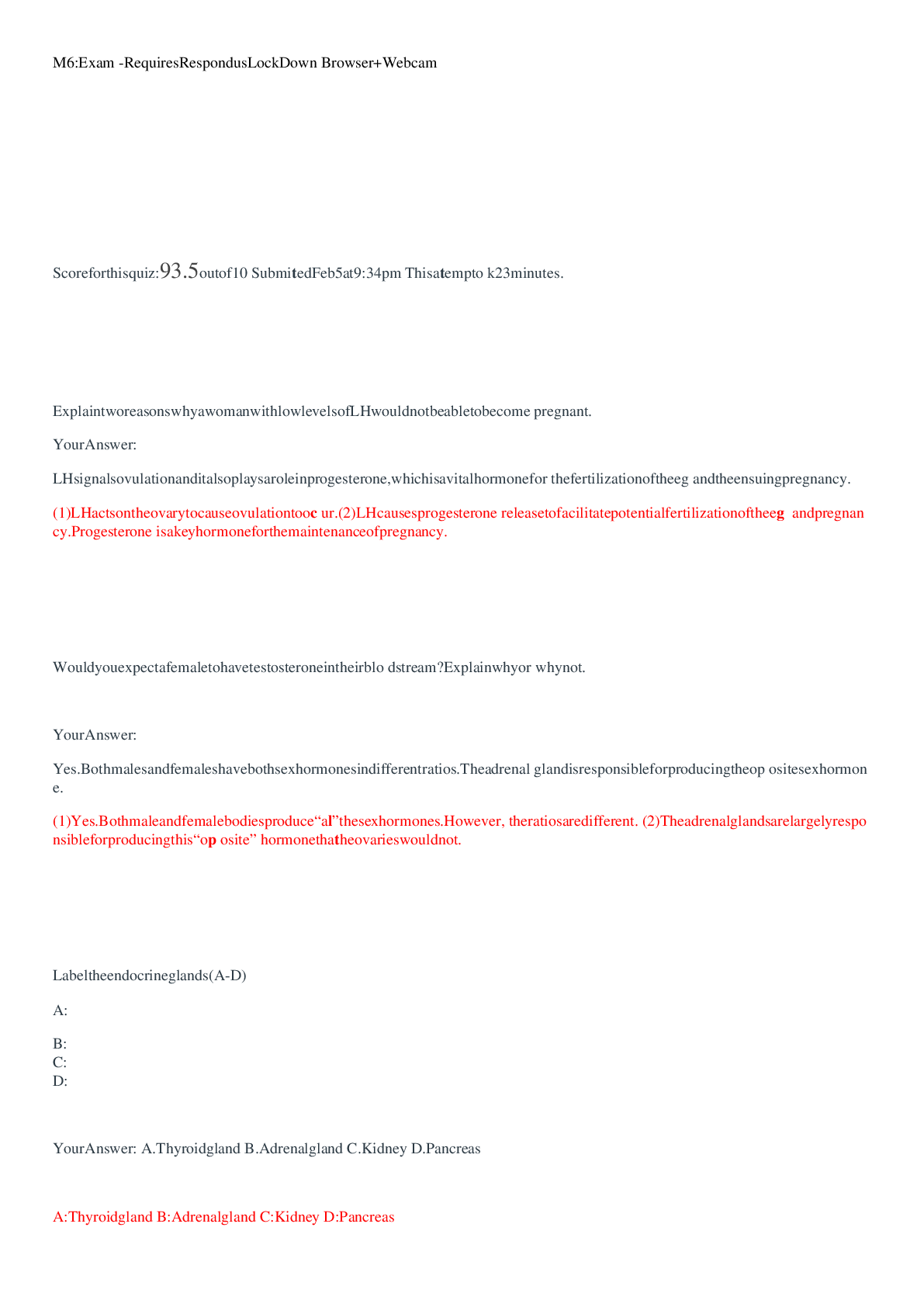
Also available in bundle (1)

Nursing 1429041 Module 6, 7, 8 and 9 Exam/ (100/100) Questions and Answers/ GRADED A/ (LATEST UPDATE 2021/2022)
Nursing 1429041 Module 6, 7, 8 and 9 Exam/ (100/100) Questions and Answers/ GRADED A/ (LATEST UPDATE 2021/2022)
By A+ Solutions 2 years ago
$17
4
Reviews( 0 )
Document information
Connected school, study & course
About the document
Uploaded On
Jun 03, 2021
Number of pages
13
Written in
Additional information
This document has been written for:
Uploaded
Jun 03, 2021
Downloads
0
Views
59




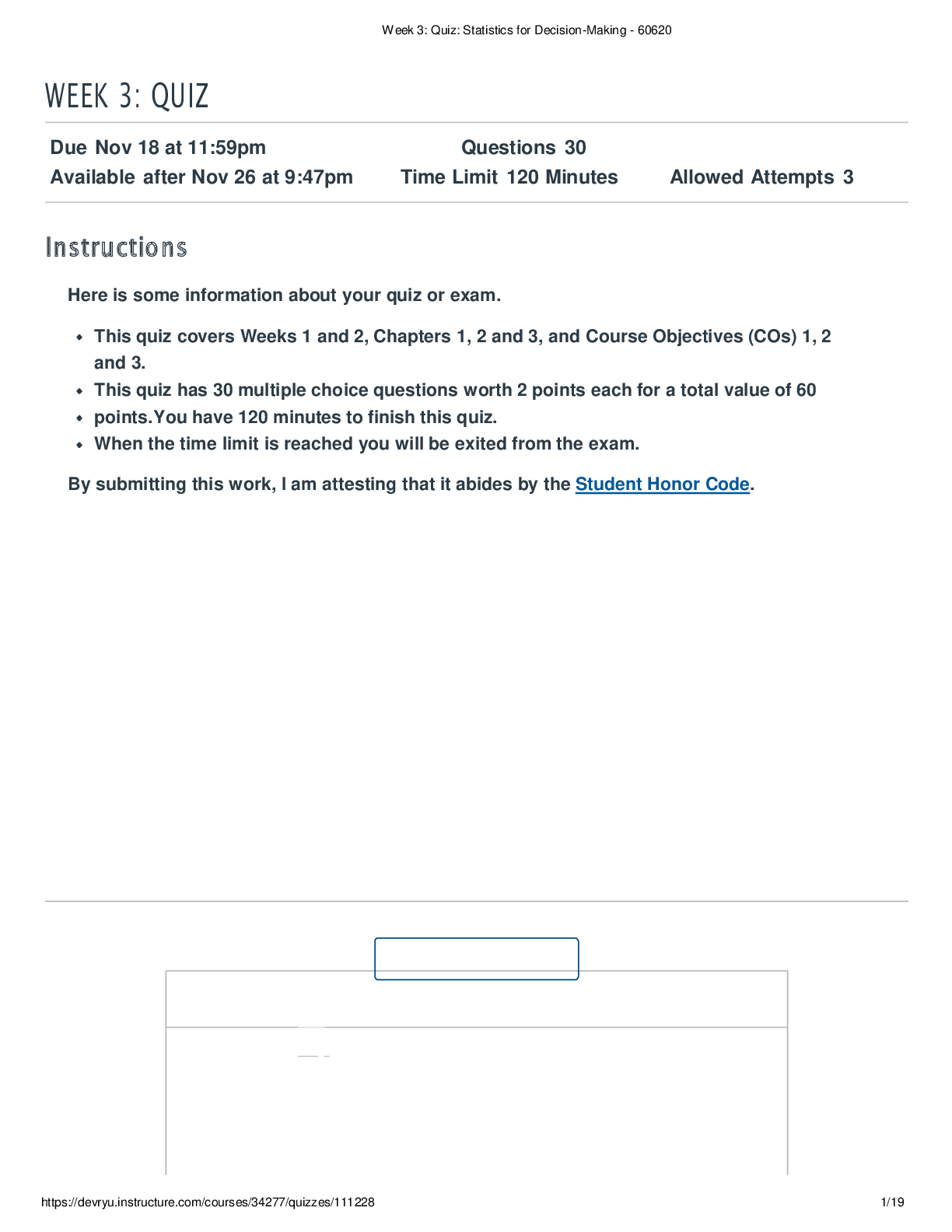

.png)











